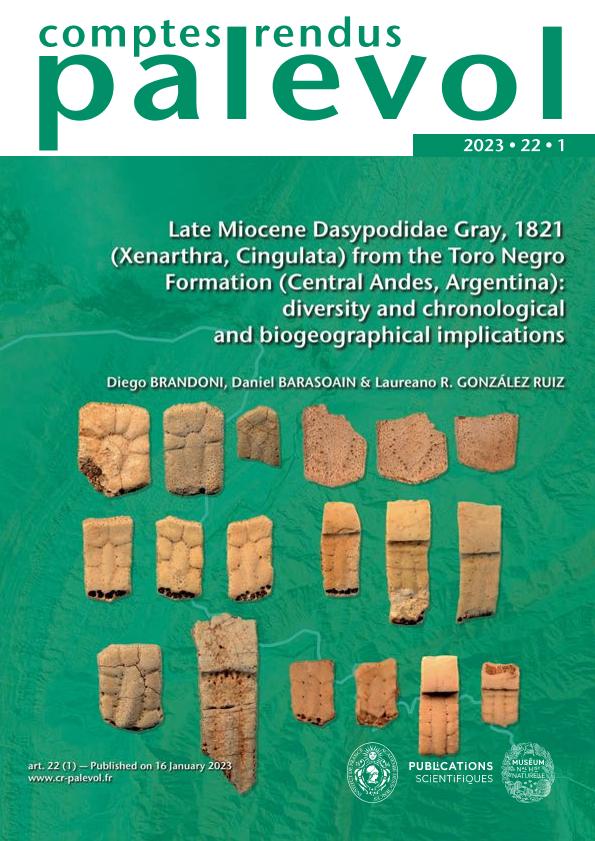Mostrar el registro sencillo del ítem
dc.contributor.author
Brandoni, Diego

dc.contributor.author
Barasoain Goñi, Daniel

dc.contributor.author
Gonzalez Ruiz, Laureano Raul

dc.date.available
2024-01-31T14:47:39Z
dc.date.issued
2023-01
dc.identifier.citation
Brandoni, Diego; Barasoain Goñi, Daniel; Gonzalez Ruiz, Laureano Raul; Late Miocene Dasypodidae Gray, 1821(Xenarthra, Cingulata) from the Toro Negro Formation (Central Andes, Argentina): diversity and chronological and biogeographical implications; Elsevier France-Editions Scientifiques Medicales Elsevier; Comptes Rendus Palevol; 22; 1; 1-2023; 1-16
dc.identifier.issn
1631-0683
dc.identifier.uri
http://hdl.handle.net/11336/225379
dc.description.abstract
Fossil remains herein described are referred to different species of Dasypodidae Gray, 1821 (Mammalia, Xenarthra, Cingulata) and come from the upper levels of the lower member (Late Miocene-Early Pliocene) of the Toro Negro Formation at Quebrada de Las Torrecillas, La Rioja Province, Argentina, where previous vertebrate records only include those of Pyramiodontherium scillatoyanei De Iuliis, Ré & Vizcaíno, 2004 (Mammalia, Xenarthra) and Opisthodactylus cf. kirchneri Noriega, Jordan, Vezzosi & Areta, 2017 (Aves, Rheidae). The remains of Dasypodidae herein presented include Vetelia ghandii Esteban & Nasif, 1996, Chasicotatus peiranoi Esteban & Nasif, 1996, Macrochorobates scalabrinii (Moreno & Mercerat, 1891), Prozaedyus sp., and Paleuphractus argentinus (Moreno & Mercerat, 1891), and constitute the first records of these species for the Toro Negro Formation, increasing the mammal diversity for this unit. The association of dasypodids here described shows strong affinities with those described for Late Miocene localities of Northwestern Argentina. Under these evidences, the Dasypodidae here reported for Quebrada de Las Torrecillas site show a characteristic association of taxa from Northwestern Argentina, suggesting a Messinian age (Late Miocene) for the bearing levels of the Toro Negro Formation. In this way, these records support the accurate ages recently proposed for the lower Member of the Toro Negro Formation (i.e., Late Miocene-Early Pliocene).
dc.description.abstract
Miocène supérieur Dasypodidae Gray, 1821 (Xenarthra, Cingulata) de la Formation Toro Negro (Centre des Andes, Argentine) : diversité et implications chronologiques et biogéographiques. Les restes fossiles décrits ici se rapportent à différentes espèces de Dasypodidae Gray, 1821 (Mammalia, Xenarthra, Cingulata) et proviennent des niveaux supérieurs du membre inférieur (Miocène supérieur – Pliocène inférieur) de la Formation Toro Negro à Quebrada de Las Torrecillas, Province de La Rioja, Argentine, où les signalements précédents de vertébrés comprennent seulement ceux de Pyramiodontherium scillatoyanei De Iuliis, Ré & Vizcaíno, 2004 (Mammalia, Xenarthra) et Opisthodactylus cf. kirchneri Noriega, Jordan, Vezzosi & Areta, 2017 (Aves, Rheidae). Les restres de Dasypodidae présentés ici incluent Vetelia ghandii Esteban & Nasif, 1996, Chasicotatus peiranoi Esteban & Nasif, 1996, Macrochorobates scalabrinii (Moreno & Mercerat, 1891), Prozaedyus sp., et Paleuphractus argentinus (Moreno & Mercerat, 1891), et constituent les premiers signalements de ces espèces pour la Formation Toro Negro, augmentant la diversité de mammifères pour cette unité. L’association de dasypodidés décrite ici présente de fortes affinités avec celles décrites pour des localités du Miocène du Nord-Ouest de l’Argentine. Compte tenu de ces éléments, les Dasypodidae rapportés ici pour le site de Quebrada de Las Torrecillas montrent une association caractéristique de taxons du Nord-Ouest de l’Argentine, suggérant un âge Messinien (fin du Miocène supérieur) pour les niveaux comprenant la Formation Toro Negro. Ainsi, ces données soutiennent les âges précis récemment proposés pour le membre inférieur de la Formation de Toro Negro (c’est-à-dire fin du Miocène supérieur – début du Pliocène inférieur).
dc.format
application/pdf
dc.language.iso
eng
dc.publisher
Elsevier France-Editions Scientifiques Medicales Elsevier

dc.rights
info:eu-repo/semantics/openAccess
dc.rights.uri
https://creativecommons.org/licenses/by/2.5/ar/
dc.subject
KEY WORDS ARMADILLOS
dc.subject
NEOGENE
dc.subject
NORTHWESTERN ARGENTINA
dc.subject
SOUTH AMERICA
dc.subject.classification
Paleontología

dc.subject.classification
Ciencias de la Tierra y relacionadas con el Medio Ambiente

dc.subject.classification
CIENCIAS NATURALES Y EXACTAS

dc.title
Late Miocene Dasypodidae Gray, 1821(Xenarthra, Cingulata) from the Toro Negro Formation (Central Andes, Argentina): diversity and chronological and biogeographical implications
dc.title
Miocène supérieur Dasypodidae Gray, 1821 (Xenarthra, Cingulata) de la Formation Toro Negro (Centre des Andes, Argentine): diversité et implications chronologiques et biogéographiques
dc.type
info:eu-repo/semantics/article
dc.type
info:ar-repo/semantics/artículo
dc.type
info:eu-repo/semantics/publishedVersion
dc.date.updated
2024-01-30T12:06:37Z
dc.identifier.eissn
1777-571X
dc.journal.volume
22
dc.journal.number
1
dc.journal.pagination
1-16
dc.journal.pais
Francia

dc.journal.ciudad
París
dc.description.fil
Fil: Brandoni, Diego. Provincia de Entre Ríos. Centro de Investigaciones Científicas y Transferencia de Tecnología a la Producción. Universidad Autónoma de Entre Ríos. Centro de Investigaciones Científicas y Transferencia de Tecnología a la Producción. Consejo Nacional de Investigaciones Científicas y Técnicas. Centro Científico Tecnológico Conicet - Santa Fe. Centro de Investigaciones Científicas y Transferencia de Tecnología a la Producción; Argentina
dc.description.fil
Fil: Barasoain Goñi, Daniel. Consejo Nacional de Investigaciones Científicas y Técnicas. Centro Científico Tecnológico Conicet - Nordeste. Centro de Ecología Aplicada del Litoral. Universidad Nacional del Nordeste. Centro de Ecología Aplicada del Litoral; Argentina
dc.description.fil
Fil: Gonzalez Ruiz, Laureano Raul. Consejo Nacional de Investigaciones Científicas y Técnicas. Centro Científico Tecnológico Conicet - Patagonia Norte. Centro de Investigación Esquel de Montaña y Estepa Patagónica. Universidad Nacional de la Patagonia "San Juan Bosco". Centro de Investigación Esquel de Montaña y Estepa Patagónica; Argentina
dc.journal.title
Comptes Rendus Palevol

dc.relation.alternativeid
info:eu-repo/semantics/altIdentifier/url/http://sciencepress.mnhn.fr/fr/periodiques/comptes-rendus-palevol/22/1
dc.relation.alternativeid
info:eu-repo/semantics/altIdentifier/doi/https://doi.org/10.5852/cr-palevol2023v22a1
Archivos asociados
